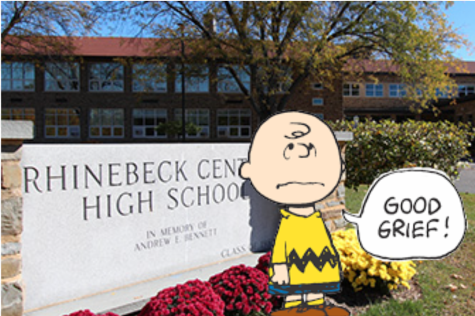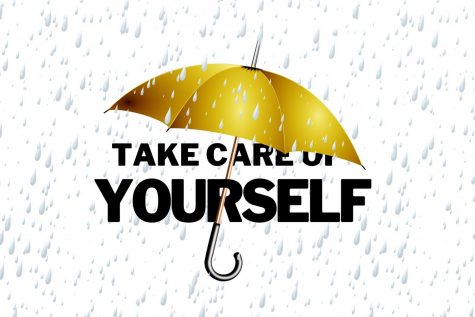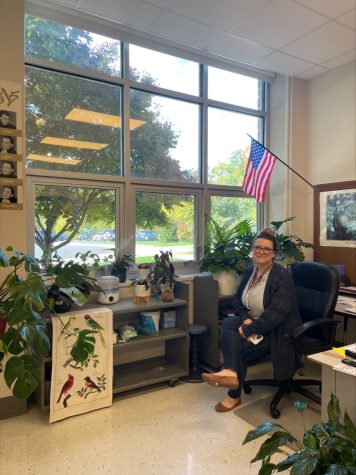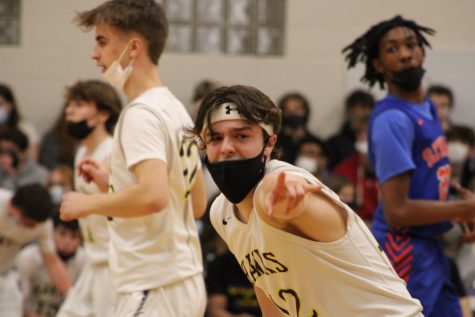World of Worriers: The Social Emotional Climate at RHS
The Social Emotional Climate at Rhinebeck High School
I have always been a worrier, the type of person who perseverates over everything. Just thinking about whether or not I will arrive at school on time, finish my homework, or win my basketball game makes me want to bite my nails until they hurt.
According to the National Institute of Mental Health, anxiety affects nearly one-third of our population in the United States. Some may point to school social and emotional climate, while others blame cell phones and social media. Severe anxiety and stress are not far away issues; they affect our own students right here at home.
In order to ease the discord, we need to set a new standard; students should be taught healthy habits to balance their school and home lives and prioritize their physical and emotional well being. We need to take a look inward and ask ourselves: how did worrying become the new norm? And when it comes to anxiety, what is normal?
We need to take a look inward and ask ourselves: how did worrying become the new norm? And when it comes to anxiety, what is normal?
About a year ago, The New York Times published an article called “Why Are More Teenagers Than Ever Suffering From Severe Anxiety?” When it appeared in her snapchat news feed, one of my friends sent it to our group chat, remarking at the accuracy of the article. The group chat contained five other girls, three of whom were in the top ten percent of our class, the other two at least in the top twenty.
All of them agreed: the author’s conclusions were dead on. In his article, Benoit Denizet-Lewis detailed the story of a boy named Jake, who was in his junior year of highschool, taking three A.P. classes, running cross country for his school’s team, and traveling to Model UN conferences when everything fell apart. Jake succumbed to crippling anxiety; under the pressure of perfection, he felt like he could never measure up. Despite their own innumerable successes, the girls in the group chat were familiar with this impending fear too.
In 2016, when surveying college freshmen, the Higher Education Research Institute at U.C.L.A found that 41% “felt overwhelmed by all they had to do,” a drastic increase from a previous 29% in 2010, and 18% in 1985 (Denizet-Lewis). But why do teenagers and young adults who have the most opportunities at their fingertips, coupled with the highest barometers for success, appear so discontent?
It’s easy to believe that teenagers in well off communities should be well off when it comes to anxiety, as they deal with seemingly fewer hardships. After all, in a volatile political climate, they don’t have to fear for their physical safety or the deportation of undocumented family members, unlike their less-fortunate counterparts. Yet Suniya Luthar, a professor of psychology at Arizona State University, who compared distress and resilience in affluent and disadvantaged teenagers, has concluded that the privileged are the most “emotionally distressed” youth in America. She claims that “These kids are incredibly anxious and perfectionistic, but there’s contempt and scorn for the idea that kids who have it all might be hurting” (Denizet-Lewis). Luthar sites a never-ending need to do better as their biggest source of anxiety, saying “There’s always one more activity, one more A.P. class, one more thing to do in order to get into a top college” (Denizet-Lewis). This sentiment resonates for many in my hometown.
The high schoolers in our district are fortunate to receive a rigorous academic curriculum delivered by teachers who are highly invested in their students’ education. Our teachers and parents alike want us to reach our highest potential, and push us accordingly. But at what cost?
To better characterize the experience of Rhinebeck’s best and brightest, I took my curiosity directly to the source: the students themselves. High school senior, Emily Miller exemplifies the high achieving, but highly stressed out profile that is prevalent in our school. When she graduates in June of 2019, she will have taken seven out of the ten Advanced Placement classes offered at Rhinebeck: AP World History, AP U.S. History, AP Biology, AP Language and Composition, AP European History, AP Spanish, and AP Literature. She fills her afternoons participating in Model UN Club, mentoring elementary school students through Culture Connect, nursing her creative side in Creative Writing Club, and serving as president of Debate Club. While Emily enjoys all of her activities, she also confesses that if she didn’t need to bolster her resume to appeal to colleges, she probably wouldn’t be as committed. Who can blame her considering the toll it takes? “Last year,” she told me, “I would come home from school around 3:00 and work on homework for a few hours. Sometimes I would unintentionally fall asleep at my desk. Even after dinner I still had homework to do.” When I asked her why she wears herself so thin, her response was simple: it’s what the competition requires of her.
In the thick of junior year, which is notorious for being the most challenging academic school year, Emily averaged four or five hours of sleep a night. As a person who rarely found herself with an hour of free time each day, Emily “used to think six hours [of sleep] a night was really good.” She explained how tough it is to go up against other students, “There’s definitely a pressure to be the best so you can get into a top school. People here really judge your worth based on the quality of the school you go to.” But Emily’s own expectations of herself far exceeded those other’s place on her. Despite her extensive extracurricular activities and impressive academic performance, Emily still knows that it will be a challenge to afford college and enter the tight job market. While she’s aware that much of her stress is self inflicted, she believes there needs to be a systematic change in the way we approach emotional well being in schools. “In the week leading up to AP testing last spring, a debilitating combination of anxiety and too much coffee made me physically sick. I wish someone had told me it was okay to let my school work take a hit when my own mental and physical health was at stake.”
Madeline Levine, founder of Stanford-affiliated nonprofit Challenge Success, notes this distinct change in stressors, “Teenagers used to tell me, ‘I just need to get my parents off my back.’ Now so many students have internalized the anxiety. The kids at this point are driving themselves crazy” (Denizet-Lewis). This shift is important; it indicates that teenagers are not taught proper skills to handle the stress they are under. Consistently, diligent students are putting their basic physical and emotional needs aside in order to be the best. Though their parents have instilled in them high standards and expectations, they are not providing them with the guidance and support that is necessary to sustain them. But that’s not to say that anxiety has failed to capture the attention of many parents, teachers, and school administrators.
The past two school years, Rhinebeck Central School District has conducted a survey of school climate in conjunction with The National School Climate Center. According to district webpage, “School Climate” refers to people’s subjective perception of school life. School Climate sets the tone for all the learning and teaching done in the school environment, and is predictive of students’ ability to learn and develop in healthy ways.” On a scale of 1-5, across the board students consistently rated social and emotional security the lowest, with a quarter of students giving it a score in the negative range. This designation transcended racial, gender, and age demographics. Social and civic learning, defined as skills in conflict resolution, self reflection, and emotional regulation, came in second to last.
Fortunately, I had the opportunity to pick the brain of Rhinebeck’s own School Social Worker, Megan Rodier, and asked her to tell me about her take on the current stress levels of high schoolers. In summary, she told me that over approximately the past seven years, she has seen a dramatic change. It used to be that students who experienced chronic, severe anxiety were a small minority and the general population experienced lower levels of anxiety, which was typically situational. Now, she’s seeing that a greater portion of the student body is under stress, and are having heightened reactions to it. There’s intense stress surrounding academic status; the pressure to do well is affecting more and more students, and kids’ standards for what that means are narrowing. “A lot of times it’s actually the parents saying that they don’t really care about their kids’ grades as long as they try and they enjoy what they’re learning.”
There’s intense stress surrounding academic status; the pressure to do well is affecting more and more students, and kids’ standards for what that means are narrowing.
When I asked her to speculate on why students are internalizing their anxiety, she pointed to a cultural shift in the way we approach our sense of self, which is woven through both our online and real lives. Though Ms. Rodier maintains that she’s not strictly anti-social media, she concedes that as an avid pinterest user, she too has developed unrealistic expectations for herself. “We save all these ideas and pins, for who we could be but, I can’t have my Pinterest life!” It’s never been easier to compare yourself to others at the click of the button, and its widely socially accepted to be constantly working on yourself, be it your intellect, your appearance, or your skills. At Rhinebeck High School, kids go to school and are comparing themselves to their peers all day long, and then go home and are doing it on instagram.
Ms. Rodier frequently works with students to get perspective on the bigger picture, and break down our perceptions of upsetting events and setbacks. We tend to get hung up on the little things and let our negative thoughts get the best of us and spiral out of control. “We’re all guilty of perseverating over the little things and only fixating on what’s right in front of us. We focus a lot on what we don’t have. That’s why I like to talk about gratitude, learning to say here’s all the things that I do have in my life and this is what fills me. With our vision always on the negative, we’re not opening up to the possibilities of positive thinking.”
Then there’s the biological side “With a lot of students I focus on breath work,” she explained, “because when we experience anxiety, our bodies are flooded with hormones, and our fight or flight response kicks in. But there’s no fight or flight to be had when we’re nervous for a test, so our body’s firing and our minds are flooded and we can’t think clearly. The first thing you can do is control your breathing because your breathing will slow down your heart rate and blood flow, neutralizing the reaction.” Her strategy entails a “five point breath”, where you count on your fingers five seconds breathing in, then five seconds out, five times. The beauty of this technique is that you can easily do it in front of others and you don’t need anything. “It only takes a minute.”
In her article “Teen Depression and Anxiety: Why the Kids are not Alright”, Susanna Schrobsdorff tackles tough mental health issues. In regards to Generation Z she says this: “They are the post-9/11 generation, raised in an era of economic and national insecurity. They’ve never known a time when terrorism and school shootings weren’t the norm. They grew up watching their parents weather a severe recession, and, perhaps most important, they hit puberty at a time when technology and social media were transforming society,” (Schrobsdorff). As so eloquently put by Janis Whitlock, director of the Cornell Research Program on Self-Injury and Recovery, “If you wanted to create an environment to churn out really angsty people, we’ve done it.” She acknowledges that helicopter parents and school can be sources of stress but Whitlock cites other factors as the main stressors. “It’s that they’re in a cauldron of stimulus they can’t get away from, or don’t want to get away from, or don’t know how to get away from,” she says (Schrobsdorff).
Social media has gone further than simply connecting us to one another across the web; it allows us to stay in touch and up to date with the rest of the world 24/7. On the other hand it also ensures that every piece of breaking news about the latest tragedy, political issue, or natural disaster appears right before our eye. According to Alexandra Patillo’s CNN article “Too much bad news can make you sick”, “constant exposure to trauma can derail our ability to cope healthily and hinder our ability to return to a relaxed state” (Pattillo). With the rapid rise of technology in our lives, it’s become impossible to avoid all of the stress hiding in your back pocket. Susanne Babbel, a psychotherapist specializing in trauma recovery explains that when you face trauma, your body goes into “fight, flight, or freeze” mode. After the perceived threat has been eradicated, the body returns to a resting state of homeostasis. But when the body is exposed to frequent or prolonged stress it interrupts its recovery. “Over time… our adrenal glands can become fatigued. Adrenal fatigue can lead to being tired in the morning, lack of restful sleep, anxiety and depression, as well as a multitude of other symptoms,” says Babbel (Patillo).
It’s tough to refute; anxiety and stress can have detrimental effects on all aspects of our lives. The negative social and emotional climate that has pervaded Rhinebeck High School is demanding our attention, as it has at many other schools across the country. To combat anxiety and stress in school and out, we need to investigate the problem and take steps to change the harmful culture that thrives here.













